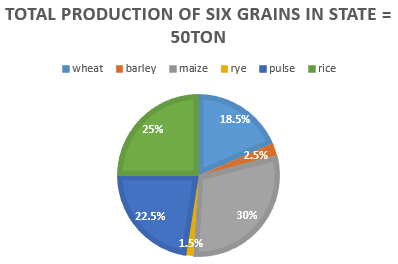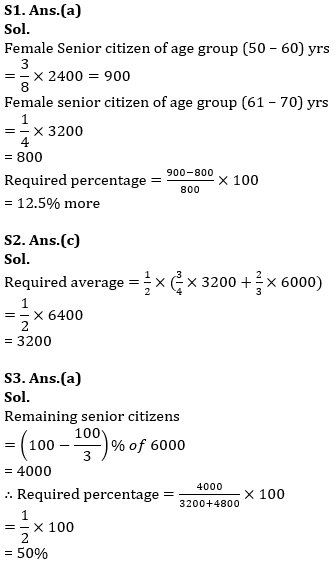Directions (1–5): The following table shows the total no. of senior citizen of different age group in Japan. Table also shows the ratio of male to female in them. Study the table carefully to answer the following questions.

Q1. Total no. of female senior citizens of age group (50–60) years are how much percent more or less than female senior citizens of age group (61–70) years?
(a) 12.5% more
(b) 12.5% less
(c) 10.5% more
(d) 10.5% less
(e) 8.5% more
Q2. What is the average no. of male senior citizens of age group (61–70) years and (81–90) years?
(a) 3600
(b) 2600
(c) 3200
(d) 2800
(e) 2300
Q3. If 33⅓% senior citizens of age group (81 –90) were died due to bad health, then senior citizen who are alive of age group (81-90) are what percent of total senior citizens of age group (61–70) years and (71–80) years together?
(a) 50%
(b) 60%
(c) 54%
(d) 64%
(e) 45%
Q4. If 20% male senior citizens of age group (71 –80) yrs are pensioners then how many male senior citizens are non–pensioner of the same age group?
(a) 2140
(b) 2440
(c) 2240
(d) 2420
(e) 2040
Q5. What is the difference between total male and total female senior citizen of age group (50 –60) and (61 –70) yrs together?
(a) 2300
(b) 2100
(c) 2400
(d) 2200
(e) 1850
Directions (6-10): In an exhibition of bikes there were three companies HONDA, PULSAR and HERO who introduced their models in the exhibition and it is found at the last of the exhibition that total 300 customers have visited exhibition. 50% customers purchased HONDA; 55% customers purchased HERO; 45% customers purchased PULSAR. 20% of customers who purchased HONDA also purchased other two brands. Customers who purchased any of two brands are 95. Customers of only HONDA are 20 more than that of only PULSAR. Customers who purchased only HONDA and PULSAR are 40.
Q6. How many of them did not purchase any of the three bikes?
(a) 15
(b) 20
(c) 05
(d) 10
(e) None of these
Q7. How many of them purchased only one company bikes?
(a) 175
(b) 160
(c) 165
(d) 170
(e) None of these
Q8. How many of them purchased at least two companies bikes?
(a) 125
(b) 105
(c) 95
(d) 130
(e) None of these
Q9. How many of them didn’t purchase only PULSAR bike?
(a) 160
(b) 105
(c) 260
(d) 265
(e) None of these
Q10. What is the total number of bikes which have been sold?
(a) 450
(b) 445
(c) 455
(d) 305
(5) None of these
Directions (11-15): Pie chart given below shows percentage distribution of production of six different grains in a state in a year. Read the data carefully and answer the following questions.

Q11. Production of pulse is how much more than production of rye? (in ton)
(a) 10.5
(b) 11
(c) 10.7
(d) 9.5
(e) 8.4
Q12. What is the ratio of production of barley and rice together to that of wheat and maize together?
(a) 11:13
(b) 55:97
(c) 13:97
(d) 22:39
(e) None of these.
Q13. If price of a Kg of barley is Rs.35 and price of a Kg of pulse is Rs. 80, if both are mixed in ratio of their production in given state, find price of per kg of mixture formed?
(a) Rs.75
(b) Rs.72.5
(c) Rs.60
(d) Rs.75.5
(e) Rs. 68
Q14. If production of wheat and maize is increased by 20% and 25% percent respectively in next year but the total production of these six grains remain the same, find total increase in production of wheat and maize together in next year?
(a) 10400 kg
(b) 5600 kg
(c) 6400 kg
(d) 7500 kg
(e) 7200 kg
Q15. What is the central angle formed by production of rice? (in degree)
(a) 45
(b) 120
(c) 90
(d) 60
(e) 75
Solutions





Click Here to Register for Bank Exams 2021 Preparation Material





 Data Interpretation Questions for SBI PO...
Data Interpretation Questions for SBI PO...
 Data Interpretation Questions For Bank E...
Data Interpretation Questions For Bank E...
 Quantitative Aptitude Quiz For Bank Main...
Quantitative Aptitude Quiz For Bank Main...





